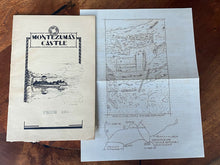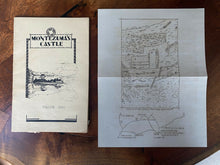An original tourist guide and map by "The Boss", Frank Pinkley (1928). Pinkley is significant because he was one of the earliest "park rangers" in Arizona that was originally asked to protect Casa Grande Ruins from destruction. Pinkley had an amazing career promoting national parks and would later open up a trading post to supplement his $17,000/yr income (2020 dollars).
"It was September 1900. The train shuddering to a stop at the Phoenix railway station carried a young passenger from Missouri. Excited by his new surroundings, 19-year-old Frank Pinkley almost forgot that he had been sent to the Arizona Territory at the order of his doctor to recuperate from a mild case of tuberculosis. He was scheduled to stay in Arizona for only six months, but this was to be the beginning of an adventure that would last a lifetime.
Little more than a year after his arrival in Arizona, Pinkley eagerly accepted the offer of a government position as caretaker of a prehistoric ruin in the desert of the Gila River valley. He lived in a tent, dug his own well, and wrote his reports to the General Land Office at a desk he had made. Sensing something very special about Casa Grande ruin, he became committed to unearthing its mysteries and communicating them to the growing number of curious visitors.
The years that followed brought a rapid succession of significant events, including an excavation program by famed archaeologist J.W. Fewkes of the Smithsonian Institution at Casa Grande between 1906 and 1908; Statehood for Arizona in 1912; Pinkley's election to the state legislature for the 1915-1916 term; and the formation of the National Park Service in 1916. When Casa Grande was designated a national monument in 1918, the fledgling National Park Service offered Pinkley the job as resident custodian, but there was a catch: he would also be expected to take charge of Tumacacori National Monument and several others.
In 1924 the Southwestern National Monuments Office was formed, and Pinkley found himself superintendent in charge of 14 monuments! As his flock of monuments grew, Pinkley was continually frustrated that funding for their protection lagged behind their needs. Lacking the name recognition of national parks, the monuments appeared to be the stepchildren of the National Park Service, clothed in hand-me-downs. In 1927 Pinkley's monuments drew more visitors than Yellowstone on less than 58 percent of Yellowstone's budget. Frequently, Pinkley paid for his own travel or went without salary at the end of the fiscal year to provide much needed repairs.
But Pinkley developed and grew as a park manager through good times and bad, always staying one step ahead of the new monuments being thrust under his care. At the time of his death in 1940, Pinkley administered 27 national monuments in four states, and was excitedly planning the development of Organ Pipe Cactus National Monument.
"The Boss," as Pinkley was affectionately known to his cohorts and employees, left a singular legacy. Ruminations from The Boss was a collection of topical, often humorous essays by Pinkley which punctuated the monthly reports compiled by his staff. In his Ruminations, Pinkley revealed an uncanny ability to explain, instruct, and cajole in a fatherly way. In 1932 Pinkley wrote prophetically. "In all this rushing and roaring around and growing into a bigger organization, let us watch carefully that the Park Service spirit, the spirit of service, doesn't evaporate."
Courtesy: NPS




